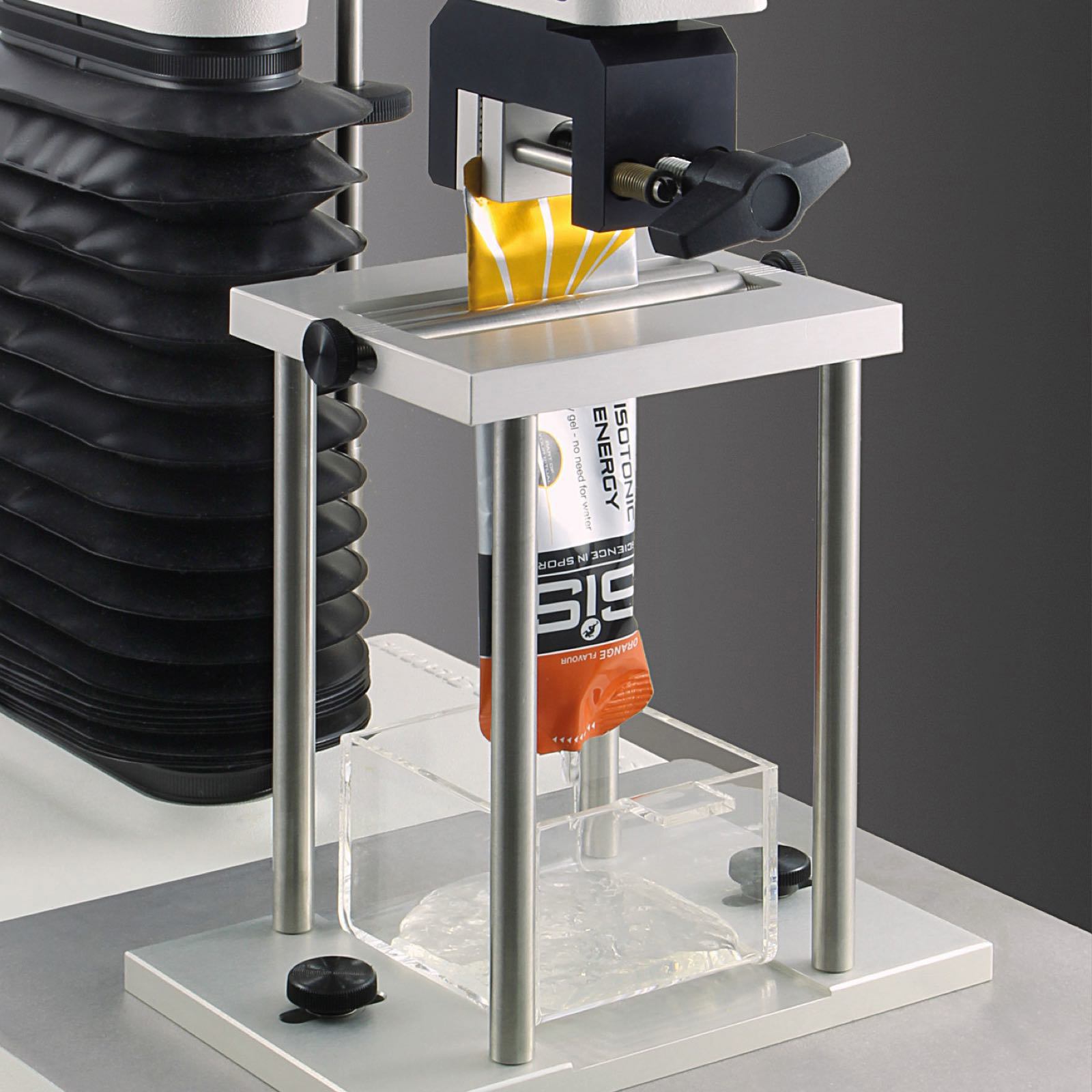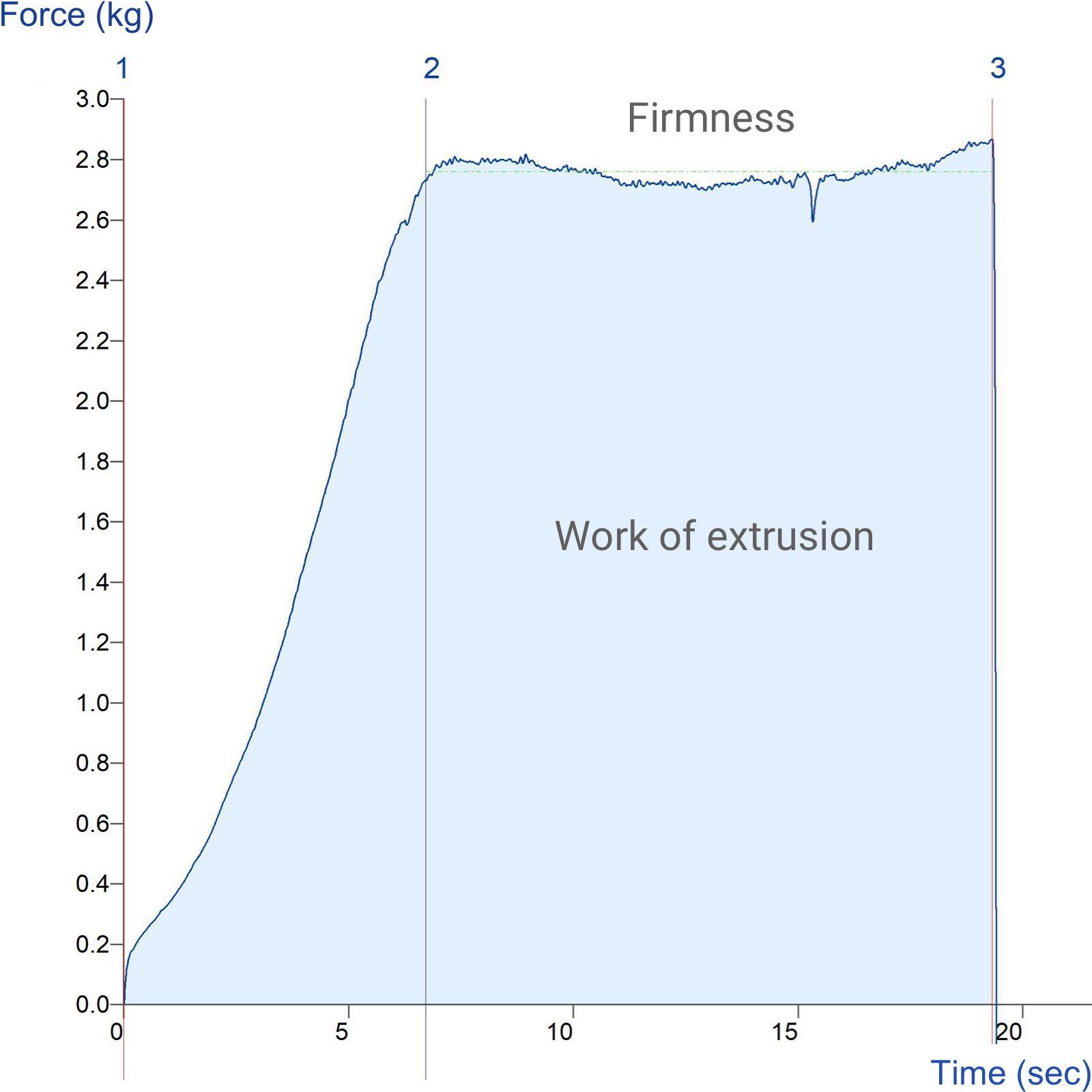How to measure extrudability

Extrudability: definition and importance
Extrudability refers to the force required to push, draw or force a material out of a container or through an orifice/opening (usually a die or nozzle). It is commonly measured using a compression-extrusion test, where force is applied to a product until it flows through one or more outlets in a test cell. The product is compressed until its structure is disrupted, and it begins to extrude.
Extrudability is important for ensuring ease of removal and application for products such as ointments, creams, gels, sauces, paint, and icings. Understanding extrudability helps product developers monitor changes in consistency over time and allows manufacturers to assess the suitability of packaging materials.
Further example applications of extrudability testing
Extrudability testing using a Texture Analyser is valuable in industries where flowability and extrusion properties are critical, such as food processing, cosmetics, and additive manufacturing. Below are key applications:
- Food product extrusion: In dough extrusion, a test shows how easily the dough flows through a nozzle. High extrudability doughs (e.g., cookie doughs) exhibit a smooth, consistent force curve. For products like tomato paste or sauces, extrudability is crucial for processing and packaging. Low-viscosity sauces will show a smooth extrusion curve, while thicker pastes may exhibit higher forces and fluctuating patterns.
- Cosmetic product testing: Assessing the extrudability of cosmetic products like creams, lotions, and gels by measuring the force needed to squeeze the product from a tube or dispenser.
- Pharmaceutical product extrusion: In pharmaceuticals, extrudability is essential for ensuring that creams and ointments can be dispensed easily from tubes or syringes. A smooth force curve in the graph indicates that the product has good flow properties and will extrude easily from its packaging.
- Polymer extrusion testing: Evaluating the extrusion properties of polymers in manufacturing, such as in injection moulding or 3D printing, provides insights into the material’s flow properties and temperature effects. Highly extrudable plastics will show smooth, consistent force curves, while poorly extrudable materials may exhibit fluctuations or require high forces.
- Sealant, caulking and adhesive extrusion: Assessing the extrudability of sealants and adhesives from cartridges or applicators by measuring the force needed to squeeze the product from a caulking gun/cartridge.
- Dental material dispensing: Testing the extrudability of dental materials, such as impression pastes and dental adhesives, by measuring the force needed to dispense them from a syringe.
- Piping and icing consistency: Evaluating the extrudability of icing and toppings for cake decoration by measuring the force required to extrude icing through a pastry tip.
- Inkjet ink extrusion: Assessing the extrudability of inkjet inks through printhead nozzles by measuring the force needed to extrude ink through the nozzle for optimal flow and print quality.
In these examples, a Texture Analyser is used to apply controlled forces/distances and measure the ease of extrusion, ensuring product quality, consistency, and ease of use across various industries.
Typical probe/attachment used for measurement
In a typical extrudability test, the force is measured to extrude a product through a defined opening or nozzle using a piston or plunger at a constant speed. Or by pulling a sample between rollers to extrude the sample from a squeezing position.
How to interpret the Texture Analyser graph
 Typical curve indicating key analysis points of an extrudability test
Typical curve indicating key analysis points of an extrudability test
When measuring extrudability, the force vs distance/time graph typically shows how much force is needed to extrude the material as the distance increases. It usually consists of an initial peak to start extrusion followed by a plateau region which may be smooth or fluctuating depending on the sample consistency and extrusion variation as the material is extruded over time. From the graph you can observe/obtain the following:
- Mean extrusion force which indicates firmness/consistency
- Homogeneity
- Removal force
- Cohesiveness
A full explanation of this curve and its analysis can be accessed within Exponent Connect software. Existing Exponent users can upgrade to Exponent Connect specification.
Below is a video example of how we can help you understand curve analysis for an example property.
Key factors affecting extrudability measurement
- Consistency/viscosity: Highly viscous materials generally show higher resistance to extrusion, requiring more force to flow through the orifice. A steep initial rise in the force curve or a higher steady-state force indicates that the material is thick or resistant to flow. Low-viscosity materials extrude easily, with lower initial and sustained force requirements. The graph will show a smooth, low-level curve. Ensuring uniform composition and preparation of samples is crucial for reproducible measurements. Materials with uniform composition extrude more easily, showing smooth force curves. Materials that contain solid particles (e.g., dough with grains, pastes with chunks) may show fluctuations in the force graph as these particles resist extrusion, indicating inconsistent extrudability.
- Temperature: The temperature of the sample and testing environment can influence the material's flow properties, especially for temperature-sensitive materials.
- Humidity: Ambient humidity levels can affect the moisture content of samples, potentially altering their extrudability.
- Moisture Content: Materials with high moisture content typically extrude more easily and show lower force requirements, as the water content facilitates smoother flow. Materials with low moisture content or that are dry tend to resist extrusion, leading to higher forces and potentially irregular flow patterns.
- Extrusion speed: The rate at which the material is extruded can influence the measured extrudability. The extrusion rate should mimic real-world usage for relevant results.
- Hole/nozzle geometry: The shape and size of the extrusion hole/nozzle can impact the flow behaviour and resulting extrudate.
Optimising extrudability measurement and analysis: The Stable Micro Systems advantage
The Stable Micro Systems Texture Analyser excels in optimising extrudability measurements through its comprehensive approach and specially designed test attachments. Equipped with various extrusion rigs, it precisely quantifies the force required to extrude samples through defined apertures, measuring properties such as firmness, consistency, and flow behaviour.
The Texture Analyser’s versatility allows for testing a wide range of materials, from foods and cosmetics to pharmaceuticals and industrial products. It captures detailed force-time-distance profiles for in-depth analysis using the advanced Exponent Connect software and customisable test and analysis parameters ensure adaptability to various extrudable materials.
Stable Micro Systems' expertise in method development and data interpretation further enhances its capabilities making it the ideal choice for industries seeking to refine product formulations and maintain quality standards in extrudability testing.
A choice of extrusion rigs to imitate consumer interaction at micro-level accuracy in force and distance.
Comprehensive analysis of graph features with high data acquisition rate.
Ability to additionally measure product dispensing weights using a Dynamic Integrated Balance.
Adjust settings to match specific product requirements or simulate real-world usage conditions.
If you need help with your extrudability measurement, we offer unrivalled support.
Be guided through the steps to successful testing and analysis of extrudability.












